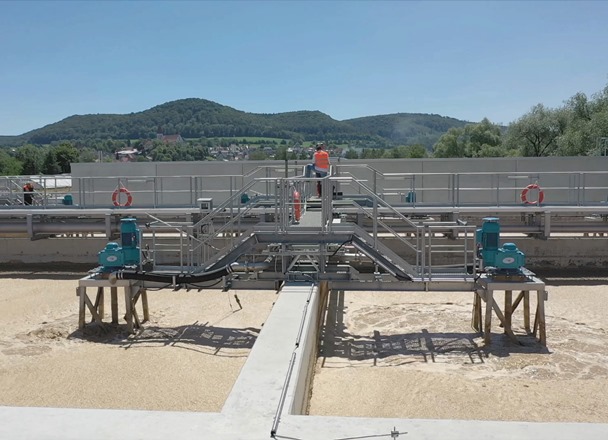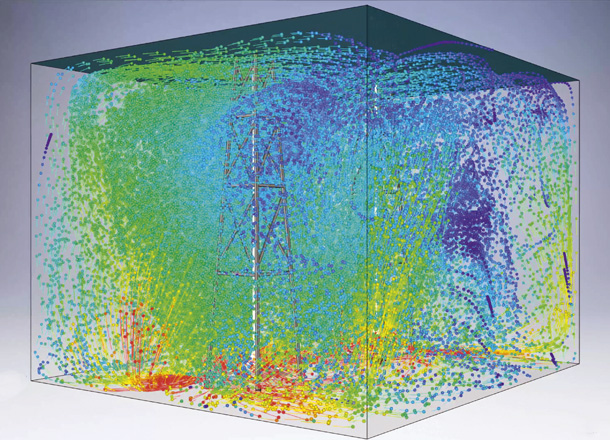INVENT Press Release
The enormous demand for brown cardboard and paperboard driven by the increase in sales figures in online trade requires especially coordinated methods and equipment for wastewater treatment. The raw material used to produce brown cardboard and paperboard is the highest possible percentage of recycled waste paper. The fibers recovered during the recycling process attribute to a high input of limescale, fillers and binding agents. Large quantities of organic compounds are discharged with the wastewater from production. A major portion of these organic compounds are already degraded in an anaerobic (without oxygen) process step. Nonetheless, yet another aerobic process step is needed to lower the pollutant loads in the wastewater to a level that allows the treated wastewater to be discharged back into the receiving waters and thus into the environment.
Challenges of aerobic treatment
In the aerobic process step, oxygen is transferred to the bacteria by an aeration system, reliably degrading the organic pollutant load. The challenge to overcome in the aerobic step is not only to realize an energy efficient oxygen transfer, but also how to deal with the difficult boundary conditions that arise in the wastewater of a paper mill in particular.
- As soon as calcareous (“hard”) water is exposed to ambient air, what occurs is a shift in the lime / carbonic acid equilibrium. Extensive lime deposits and sedimentation of lime particles occur in the entire basin (walls, pipelines, etc.). The sediments are loose and, due to their high density, are deposited on the basin floor if they cannot be sufficiently stirred up by a mixing device.
- The sediment lime is deposited in the sludge flakes, and as such, in addition to the oxygen injection, the agitation rate must also be sufficiently high in order to distribute this heavy sludge homogeneously throughout the basin, optimally run the aerobic process and prevent deposits.
- Boundary conditions such as high temperatures, large injection depths and lime sediments cause damage, bringing about an interruption in the oxygen supply in many aeration systems. The particles can cause the aerators to close up and be clogged (major increase in the pressure loss) and reduce transfer performance. Ultimately, the aerobic process step is no longer able to achieve the planned degradation performance, causing the effluent values of the wastewater treatment plant to exceed the approved target values. This impacts the maximum possible production capacity.
The HYPERCLASSIC®-Mixing and Aeration System – the energy-efficient, reliable and low-maintenance solution
The HYPERCLASSIC®-Mixing and Aeration System is a mechanical aeration system, which has been in use in industrial wastewater treatment plants for over 20 years. With a unique combination of mixing and aeration system, INVENT provides the solution for the demanding tasks of aerobic wastewater treatment. Especially in the wastewater resulting from paper production, because of the specific characteristics of the components, all of the problems in the aerobic process step are successfully avoided:
- Oxygen is transferred through a ring sparger, which is installed leak-tight above the basin floor. This design ensures a high injection depth and long dwell time of the air bubbles. In addition, the large injection openings ensure many years of aeration operation with no blockages, loss of pressure or efficiency.
- The high injection efficiency or rather the ability to generate fine air bubbles is the result of stainless steel ribs on the bottom of the mixer-body. During aeration operation, the mixer-body rotates continuously, producing very fine bubbles in the trail of the stainless steel ribs. They are transferred and distributed laterally, radially into the basin with the mixer flow.
The HYPERCLASSIC®-Mixing and Aeration System also exhibits its high degree of flexibility when integrated into a wastewater treatment plant.
- All that is needed to operate each unit is an air and power connection. Each unit can feed an entire basin with up to 2,000 Nm³/h air.
- The HYPERCLASSIC®-Mixing and Aeration System can be delivered in a stainless steel cage, thus making it easy to lift when needed without having to empty the aeration tank. Because of its own weight, it is safely positioned at the installation site.
These unique characteristics have made the HYPERCLASSIC®-Mixing and Aeration System the industry standard in the field of aerobic treatment of paper wastewater over the recent decades. No matter whether the largest paper machine in Europe, the most state-of-the-art production plant in Europe or specialist manufacturers, each of them rely on the efficient, reliable and low-maintenance system from INVENT.
In 2020, a total of twelve HYPERCLASSIC®-Mixing and Aeration System were installed in the Palm GmbH & Co.KG paper mill in Aalen, Germany. Each system distributes up to 1,800 Nm³/h at an injection depth of up to 11.5 m. The overall specification and the selection of materials meet the highest standard for use in the wastewater of a paper factory.




